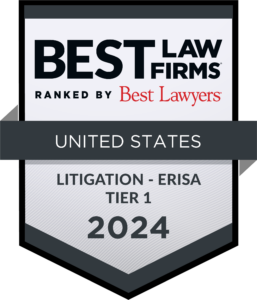In a decision with far-reaching implications, the U.S. District Court for the Northern District of Texas, issued a decision in Faulk Company, Inc. v. Xavier Becerra et al., invalidating an assessment against Faulk Company for failure to provide its employees with health coverage. This assessment, called an Employer Shared Responsibility Payment (“ESRP”), is an excise tax that is assessed against employers of a certain size who fail to offer their full-time employees health coverage that meets applicable requirements of the Affordable Care Act (“ACA”). More importantly, the Court also invalidated the regulations by which the Internal Revenue Service (“IRS”) assesses the ESRP. If not overturned by an appellate court, this decision could arguably result in the invalidation of all ESRPs previously assessed by the IRS.
The Court’s decision relies on an interpretation of the interaction between two provisions of the ACA, each under the jurisdiction of a different agency: (i) Section 1411, which lays out the process for determining whether an individual is entitled to a premium tax credit on the Health Insurance Marketplace (“Exchange”), under the authority of the Department of Health and Human Servies (“HHS”), and (ii) Section 4980H, which lays out the process by which the government assesses and collects the ESRP, under the authority of the IRS.
Background
The ACA’s “employer mandate” requires that employers with fifty or more full-time equivalent employees must provide their employees with health coverage that meets certain requirements, including “affordability.”[1] As noted above, this mandate is enforced through the ESRP excise tax. If an employer is required to offer compliant health coverage but fails to do so, a full-time employee may be eligible for financial assistance from the government, known as a premium tax credit, to buy their own insurance through the Exchange. If one or more full-time employees receive the premium tax credit, it can trigger an ESRP assessment for the employer. The IRS uses Letter 226-J to inform an employer that it may be liable for an ESRP.
Section 1411
As noted above, Section 1411 of the ACA is under the authority of HHS, and it lays out a process for determining whether an individual who applies for coverage on the Exchange is eligible for a premium tax credit to purchase individual health insurance coverage. Part of this process is to determine whether the individual has been offered health coverage from their employer, and whether that coverage was affordable. Section 1411 requires that if the individual is eligible for a premium tax credit because the individual’s employer either does not provide health coverage or the coverage provided is not affordable, the Exchange must notify the employer of such fact and that the employer may be liable for an ESRP. Section 1411 also requires that the Exchange notify the employer of its appeal rights.
Section 4980H
Section 4980H of the Internal Revenue Code (“IRC”) details the process by which the IRS can assess the ESRP against employers. An employer must fail to offer the coverage and receive “certification” under ACA Section 1411 of such failure before the IRS can assess the penalty. Specifically, Section 4980H(a)(2) requires as follows:
[At] least one full-time employee of the applicable large employer has been certified to the employer under section 1411 of the [ACA] as having enrolled for such month in a qualified health plan with respect to which an applicable premium tax credit…is allowed or paid with respect to the employee. (Emphasis added.)
Section 1411 Regulations
In 2013, HHS issued regulations in which it delegated authority to the IRS to make the required certification to the employer (the “HHS Certification Regulation”).[2]The IRS uses Letter 226J to complete the certification requirement. At issue before the Court was whether HHS’s delegation of the authority to the IRS to complete the required certification was valid.
District Court Decision
Faulk is a Texas company that provides janitorial services for schools in Texas. Faulk offered health insurance to its employees as required by the ACA through 2019, when it stopped offering the coverage. In December 2021, the IRS sent Faulk a Letter 226-J, proposing an ESRP because Faulk failed to provide health insurance to its full-time employees, as required by the ACA.
The Letter 226-J purported to serve as a “certification” to Faulk prior to the assessment of the ESRP. Faulk disagreed with the proposed tax and paid the ESRP “under protest.” In January 2022, Faulk filed a refund claim with the IRS for the 2019 ESRP. In June of 2024, he filed a lawsuit.
The parties filed cross-motions for summary judgment and the Court ruled in favor of Faulk, holding that HHS ₋₋ not the IRS ₋₋ is responsible for certifying an employers’ liability under the ACA, which then enables the IRS to assess an ESRP. The Court also invalidated the HHS Certification Regulation and directed the IRS to refund Faulk’s ESRP.
The Government had argued that the IRS does not need a certification from HHS before assessing an ESRP, based on the following reasons:
- Section 1411 does not use the word “certify” when discussing employer penalties and the statute merely requires the IRS to act consistently with its provisions, indicating there is no clear legal obligation for HHS to issue a formal certification.
- The IRS, not HHS, collects the relevant health coverage information from employers, making the IRS better positioned to determine whether a penalty should apply.
- The IRS already uses the collected coverage data to issue Letter 226-J, which notifies employers of potential penalties.
- Requiring a certification from HHS would be impractical because it would require HHS to send certifications every month, even though Section 1411 does not mention any monthly requirement.
The Court disagreed with the Government’s interpretation of the relevant provisions of the ACA and held that:
- A certification must originate from HHS before the IRS may impose an ESRP.
- The relevant notices issued by HHS under the ACA (i.e., the notices HHS is required to send to employers about their liability and appeal rights) are interpreted as the required certification, even if the statute does not specifically state this to be the case.
- HHS, not the IRS, is better situated to make advance determinations and coordinate both the IRS and the Exchange, and it is able to facilitate monthly certification.
- The IRS improperly assessed an ESRP against Faulk because it failed to obtain the required certification from HHS.
- Regulatory efforts to delegate HHS’s certification duties to the IRS exceeded statutory authority and were unlawful.
- The HHS Certification Regulation is void and unenforceable.
If not overturned on appeal, this decision will result in the IRS and HHS having to create a new process for assessing ESRPs — one in which HHS plays a more active role. It may also entitle employers assessed an ESRP previously to a refund of the amounts paid to the IRS.[3] As of the date of the article, the IRS has not issued guidance in response to this decision.
If you have questions regarding the impact of this decision, please contact us.
[1] Employer-provided coverage is considered affordable for an employee if the employee required contribution is no more than 9.5 percent (as adjusted annually) of the employee’s household income. Because employers usually do not know employees’ household incomes, they can use three safe harbors based on information the employer does have available, such as the employee’s Form W-2 wages or the employee’s rate of pay.
[2] 45 C.F.R. § 155.310(i)
[3] Generally, a claim for refund must be filed within three years from the date the applicable tax return was filed or two years from the date the tax was paid, whichever is later. If no return was filed (as is the case with an ESRP), the claim must be submitted within two years from the date the tax was paid. To request a refund of an erroneously assessed ESRP, an employer may file Form 843, Claim for Refund and Request for Abatement.



